Hello and (a very) delayed happy Easter if you were celebrating. I travelled to my hometown, Warsaw, in Poland and took this past week off to recharge and spend more time with my family and friends here. Resting doesn’t come naturally to me, and as much as I love being off work and having lots of time on my hands, I often fall into the trap of active relaxation — convincing myself that’s the only way I can relax. For that reason, I started writing this post on my phone while taking a break from a cycle I took myself on, when sunbathing in my parents’ garden just wasn’t cutting it.
I know exactly where I inherited this “active rest” from — which, let’s face it, is an oxymoron. My mum, bless her, took a day off to spend more time with me but also to have a proper rest after Easter. Because if there’s one thing you need to know about Polish Easter, it’s a three day affair, consisting of churchgoing, cooking up eggs every way imaginable, and visiting family or having them over for Easter breakfast, lunch, and dinner. In short, it’s full-on, but also immensely wholesome and delicious. That being said, especially after having my brother and his little kids over at ours and travelling a couple of hours by car to see my grannie, rest was the last thing she got over Easter.
Growing up, I couldn’t quite get why she called cleaning or cooking her way of relaxing — but these days, I do. When yesterday, the two of us found ourselves with a day off and plenty of time for rest, we began our day by taking our dog on a long walk and going for a cycle. Only around the afternoon did we sit down on the sofa, and after about 30 minutes of chatting and eating Easter cakes, we proceeded to look up recipes for the leftover duck we had from the holiday dinner. There goes our rest.
My mum said something about using the duck to make pierogi (Polish dumplings), but given my current obsession with anything crunchy, spicy, and fresh — and my cravings for Asian or Middle Eastern cuisine that always kick in around this time of year, when for the first time pasta becomes a secondary choice and a poke bowl becomes my lunch and dinner — I suggested we make gyoza instead.
Delighted by the fact that my mum didn’t know what gyoza were, I quickly googled a recipe for duck gyoza, as it dawned on me that the tender and sweet roasted duck meat would pair perfectly with soy sauce, ginger, and some crunchy cabbage. She was instantly hooked and started googling the best recipes for them, trying to understand the process before we proceeded to roughly follow the guidelines but really adapting it to suit our tastes and preferences, as we do. We combined two different recipes we found, and that’s how our homemade gyoza dumplings with duck and Chinese cabbage were born. The result was something more resembling pierogi in their texture — we think it’s because we should have rolled the dough even thinner — but the filling was juicy and exactly the way you would want it to be in a gyoza. I made a quick dipping sauce with soy sauce, sesame oil, and rice vinegar, which was frankly delicious as well.
The most stressful part of it all was frying them, as I set my mum the task of also taking pictures with my film camera. Bad idea, because I slightly burnt a few dumplings while instructing her how to use it. Great idea, because now I have more pictures to share here for you to see it step-by-step. Point is: be careful when frying them, as it only takes 1–2 minutes for them to get nicely browned. Don’t flip them before adding hot water, covering them with the lid, and leaving them alone for a few minutes. The dumplings should be soft and juicy after steaming — it’s best to check if they’re ready by gently piercing them with a fork.
And so, without further ado, here is a recipe for gyoza with leftover roasted duck — the Polish way. I also included a vegetarian filling option in the recipe for my plant-based readers, as the dough itself is just flour and water, so the whole recipe can easily be adapted to suit different palates and preferences!
Homemade Gyoza Dumplings
Makes about 24 dumplings.
Ingredients
For the dough
400g plain flour
200ml hot water
Pinch of salt
Sunflower oil for frying
For the filling (meat)
350g roasted duck, chopped. This is a recipe using a leftover roasted duck, but if cooking from scratch use 300g duck breast. Prep instructions below.
2–3 spring onions, finely chopped. We used leek instead, as we didn’t have any spring onions at home. Use about 1/2 cup of the finely chopped green part of the leek.
1/2 cup grated carrot
1 cup Chinese cabbage, shredded
1 tablespoon soy sauce (or tamari for gluten-free) or more to taste
2 cloves garlic, minced
2 teaspoon grated ginger
1 teaspoon potato starch (helps bind the filling by absorbing moisture)
Salt and pepper to taste
This was an unusual filling choice for me, as I normally go for a vegetarian gyoza. So I decided to include a recipe I found online for a vegan filling too. That way this recipe can also serve my plant-based friends.
For the filling (veg)
1 cup finely shredded Chinese cabbage
1/2 cup grated carrot
1/2 cup finely chopped mushrooms (shiitake, chestnut, or button)
2-3 spring onions, finely chopped
1 garlic clove, minced
1 teaspoon grated ginger
1 tablespoon soy sauce (or tamari for gluten-free) and more to taste
1 teaspoon sesame oil
1 teaspoon potato starch
Salt and pepper to taste
For the dipping sauce
2 tablespoons rice vinegar
3 tablespoons soy sauce
1 teaspoon toasted sesame seeds
1 teaspoon sesame oil
1 spring onion/leek finely sliced
Pinch of sugar
Method
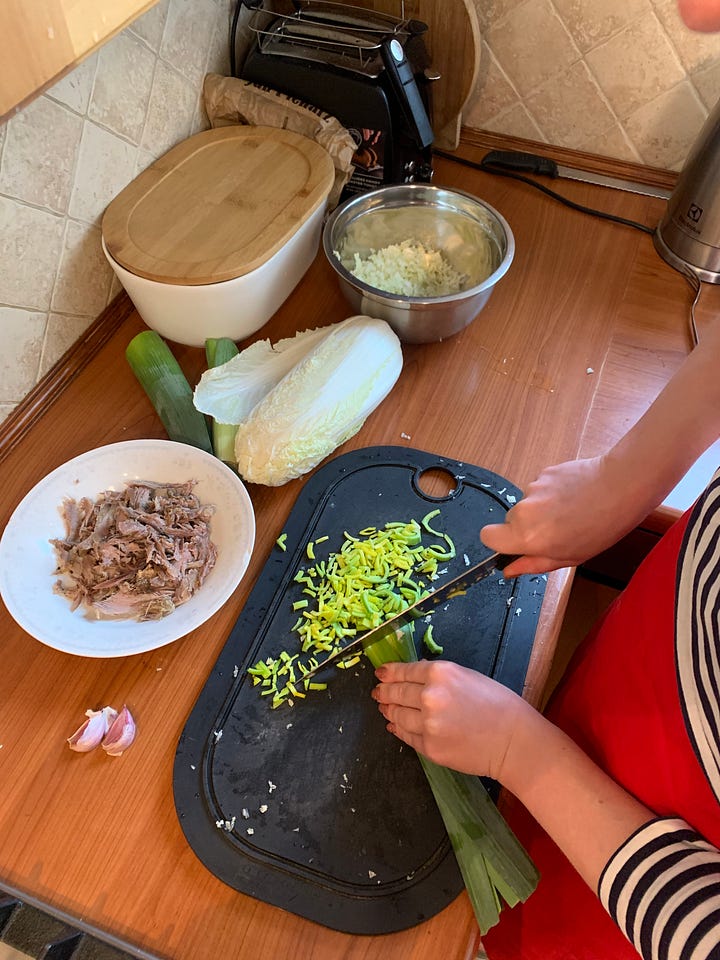
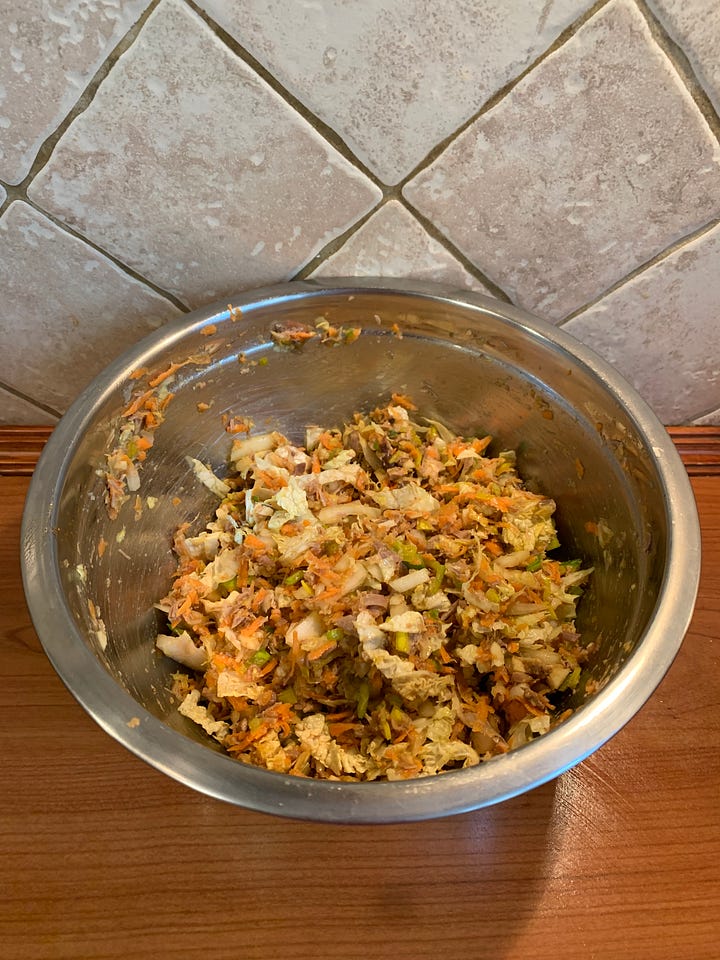
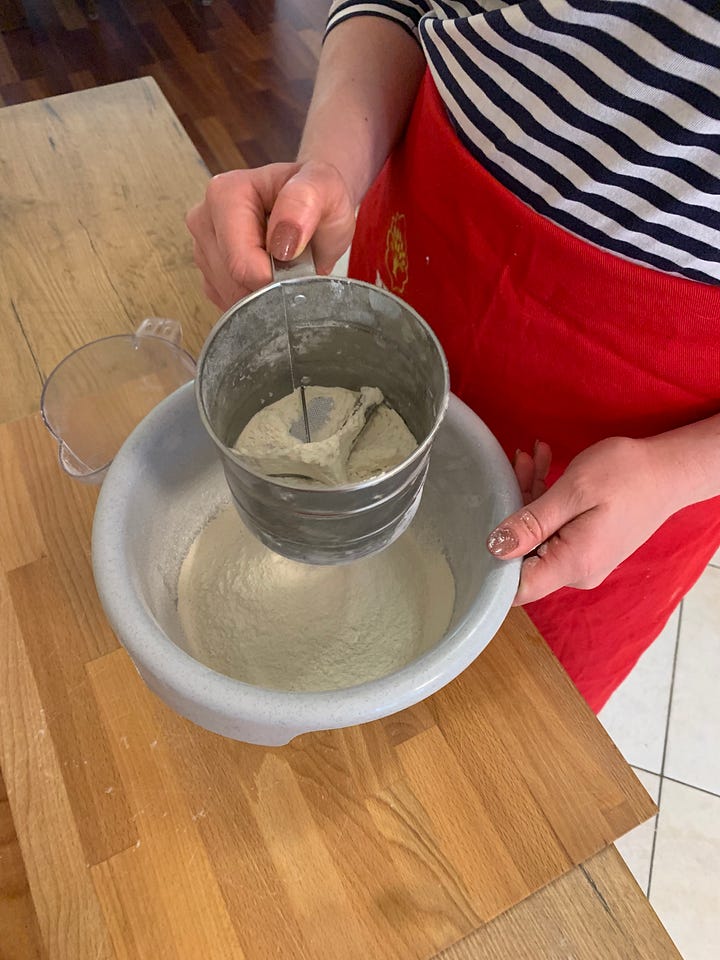
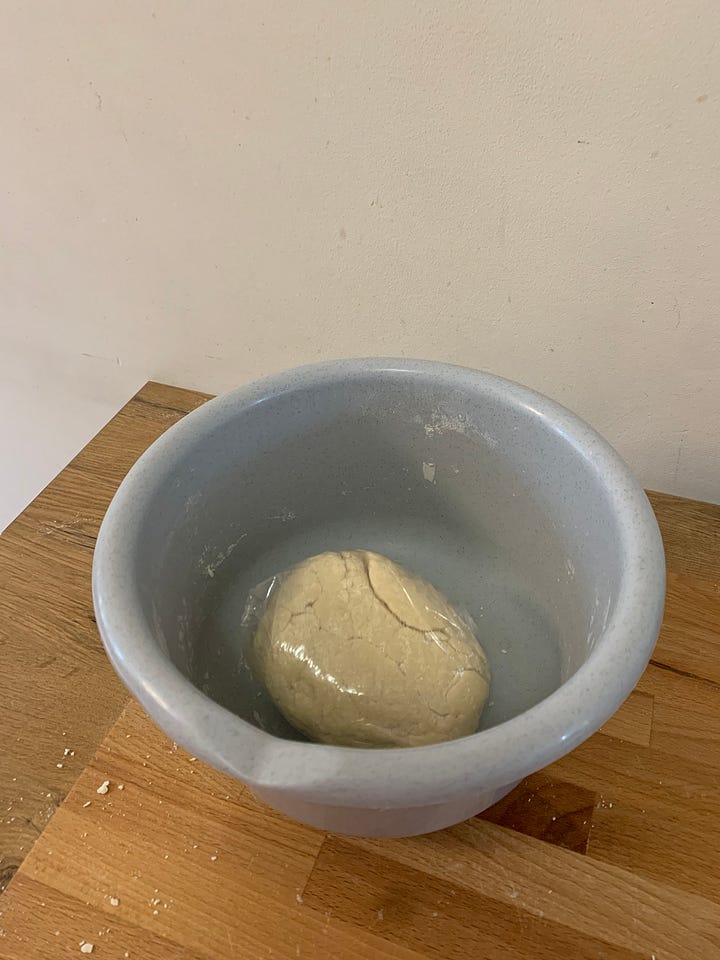
Pour the flour in a large bowl or onto a pastry board. Make a well in the center and pour in the hot water. Knead the dough.
When the dough becomes elastic and smooth, form it into a ball. The dough should be soft — if it’s difficult to knead, add a little more water.
Wrap the ball of dough tightly in cling film and set it aside to rest for at least half an hour. While the dough is resting, work on the filling.
Mix all the ingredients for the filling in a large bowl. Cover and refrigerate. If using duck breast: Rub the salt onto the skin of the duck breast and place in a frying pan skin-side down. Bring the pan to a medium–high heat and cook off without any oil (plenty of fat will start to render off the duck skin) for 6 minutes, then turn and fry for 5 minutes more. Set aside to cool, then finely chop and mix together with the rest of the filling ingredients in a mixing bowl.
After half an hour, divide the dough into four parts.
Roll each part into a log, like you would for gnocchi.
Cut the log into sections about 3 cm long.
Roll each section into a ball. Then roll each ball into a round wrapper, about 10 cm in diameter.
The edges of the wrapper should be thinner than the center — this will make it easier to seal the dumpling.
Place a heaped teaspoon of filling onto each dough wrapper.
Form the dumplings by folding the edges into a delicate accordion shape. I’m not going to pretend I know the exact folding technique, but I found some helpful instructions on here.
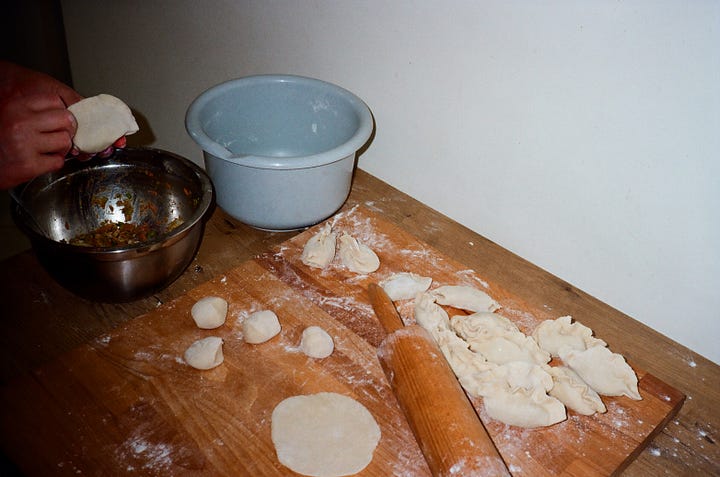
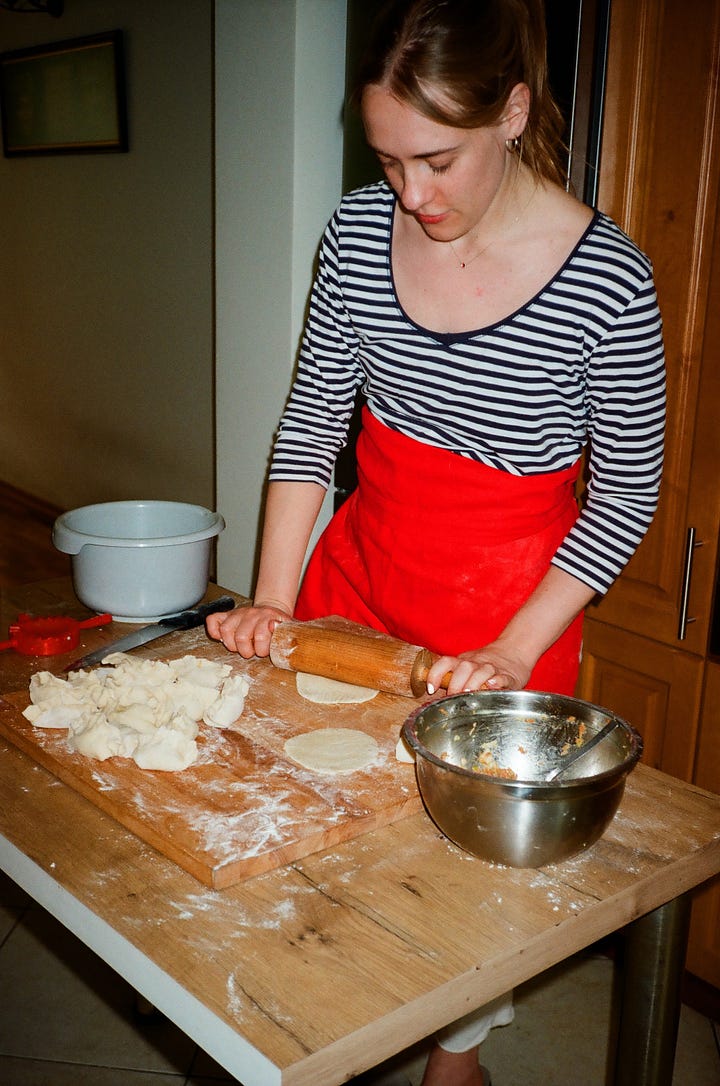
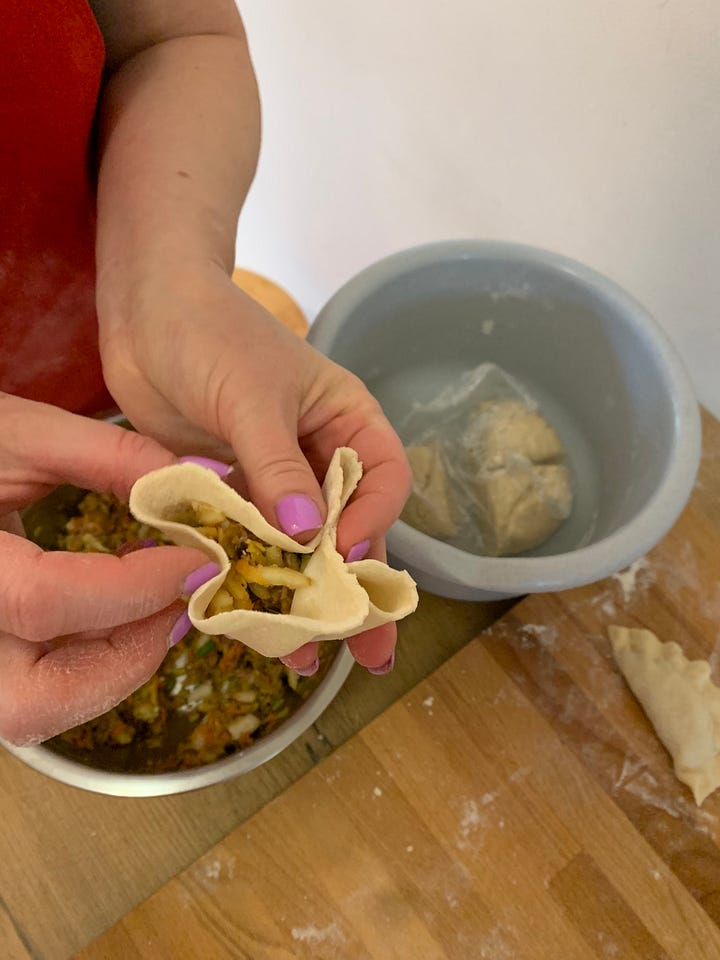
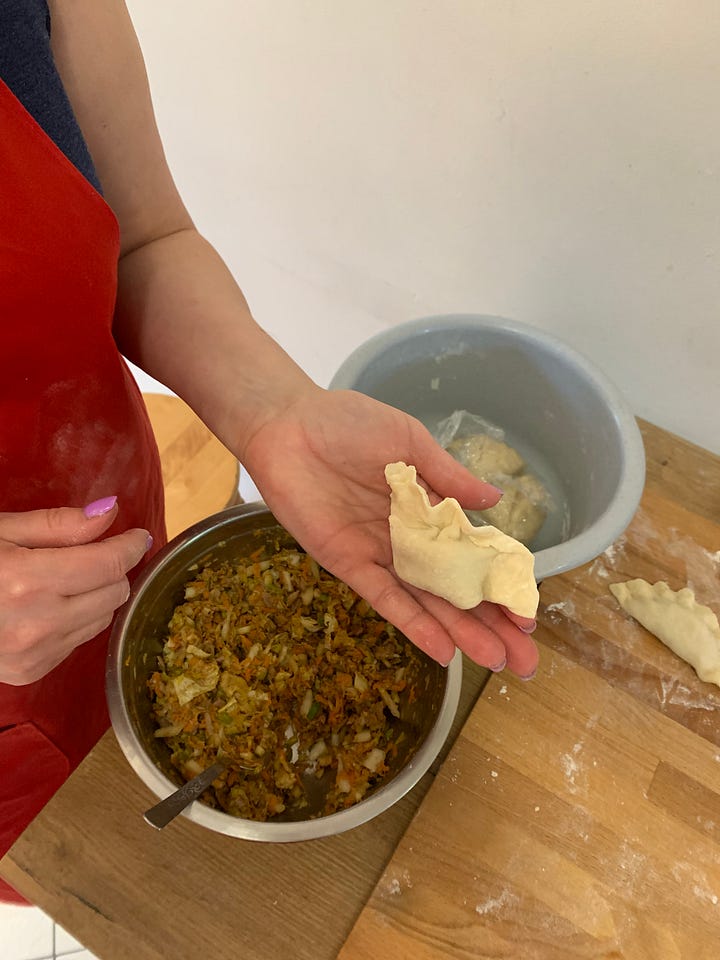
Fry the dumplings in hot oil. They burn very fast, so watch out... ours were a tad too dark.
When one side is browned, add a splash of water and cover with a lid. Cook for 6–8 minutes.
Remove the lid and fry again until the water evaporates and the bottoms are nicely crisped. The dumplings are ready when they’re golden brown and lightly springy to the touch.
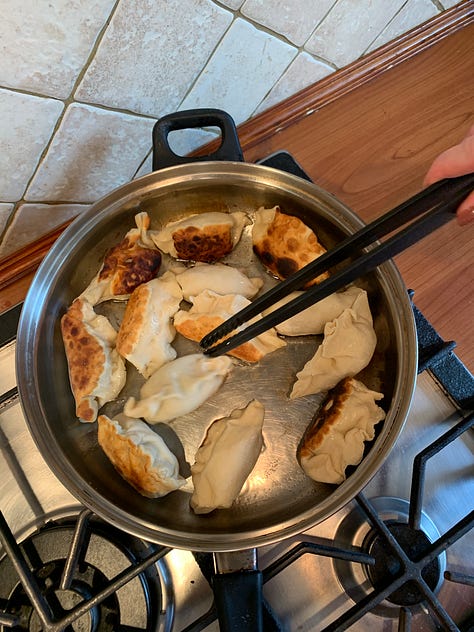
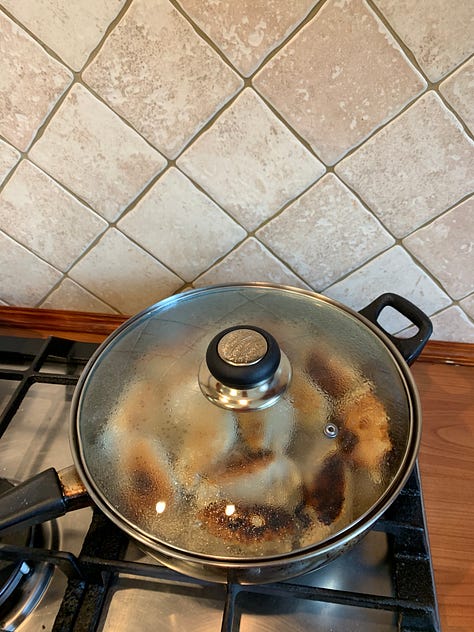
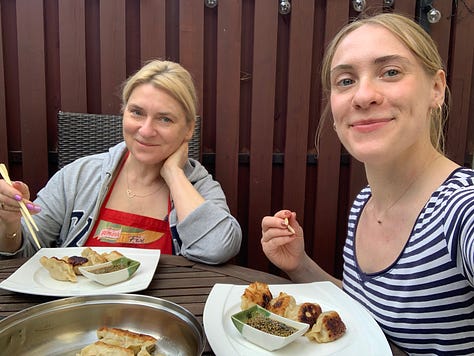
Enjoy!






